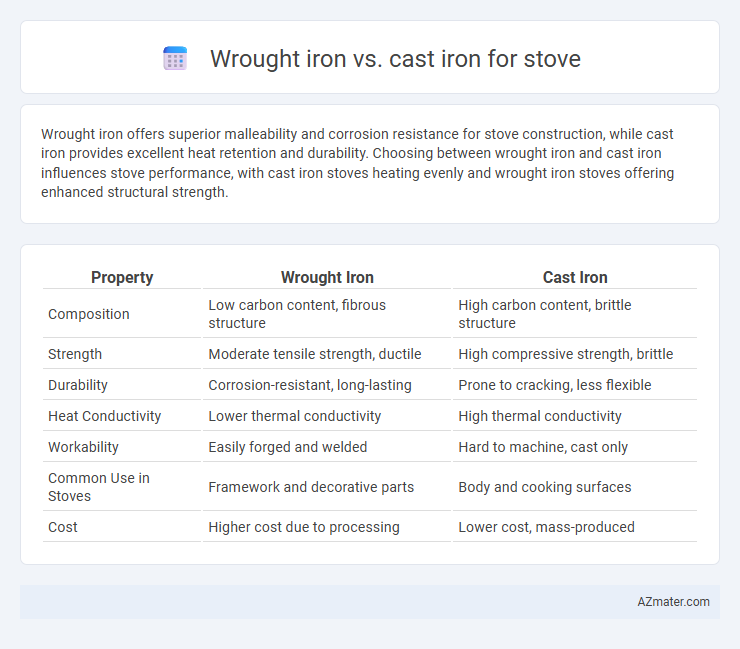Wrought iron offers superior malleability and corrosion resistance for stove construction, while cast iron provides excellent heat retention and durability. Choosing between wrought iron and cast iron influences stove performance, with cast iron stoves heating evenly and wrought iron stoves offering enhanced structural strength.
Table of Comparison
| Property | Wrought Iron | Cast Iron |
|---|---|---|
| Composition | Low carbon content, fibrous structure | High carbon content, brittle structure |
| Strength | Moderate tensile strength, ductile | High compressive strength, brittle |
| Durability | Corrosion-resistant, long-lasting | Prone to cracking, less flexible |
| Heat Conductivity | Lower thermal conductivity | High thermal conductivity |
| Workability | Easily forged and welded | Hard to machine, cast only |
| Common Use in Stoves | Framework and decorative parts | Body and cooking surfaces |
| Cost | Higher cost due to processing | Lower cost, mass-produced |
Introduction to Wrought Iron and Cast Iron
Wrought iron is a tough, malleable metal with a fibrous structure, known for its corrosion resistance and ability to be easily welded, making it ideal for custom stove components requiring durability and intricate designs. Cast iron, characterized by its high carbon content and excellent heat retention, is brittle yet strong, commonly used in stove construction for superior heat distribution and longevity. Understanding the distinct properties of wrought iron and cast iron helps in selecting the right material for stove manufacturing based on durability, heat management, and aesthetic preferences.
Composition and Manufacturing Differences
Wrought iron stoves are made from nearly pure iron with very low carbon content (typically less than 0.08%), produced by manually working the metal to create a fibrous structure that enhances toughness and malleability. Cast iron stoves consist of iron with higher carbon content (2-4%) and various alloys, manufactured by melting and pouring into molds, resulting in a brittle but hard and heat-retentive material ideal for stove surfaces. The difference in carbon composition and manufacturing processes influences durability, heat conduction, and resistance to cracking in both wrought and cast iron stoves.
Strength and Durability Comparison
Wrought iron stoves offer exceptional strength due to their fibrous grain structure, making them highly resistant to cracking under stress. Cast iron stoves, while durable with excellent heat retention, are more brittle and prone to chipping or cracking from sudden temperature changes or impacts. The superior flexibility of wrought iron ensures longer lifespan and better resistance to warping compared to the harder but less resilient cast iron.
Heat Retention and Distribution
Wrought iron stoves excel in heat retention, maintaining consistent temperatures due to their dense, fibrous structure that slowly releases heat over time. Cast iron stoves offer superior heat distribution with their ability to absorb and spread heat quickly across the surface, providing an even cooking environment. For efficient stove performance, wrought iron benefits long-lasting warmth while cast iron ensures uniform heat for precise cooking control.
Resistance to Corrosion and Rust
Wrought iron exhibits superior resistance to corrosion and rust compared to cast iron due to its dense, fibrous structure and lower carbon content, which helps prevent cracking and rust formation. Cast iron, although strong and heat-retentive, is more prone to rust because of its higher carbon content and brittle nature, making it absorb moisture easily if not properly coated or maintained. For stove applications, wrought iron is preferable in environments with high humidity or exposure to moisture, ensuring longer durability and reduced maintenance.
Maintenance Requirements
Wrought iron stoves require regular cleaning and occasional oiling to prevent rust and maintain their smooth surface, while cast iron stoves need thorough seasoning and careful monitoring for cracks due to their brittle nature. Wrought iron's flexibility allows it to withstand temperature changes better, reducing the frequency of repairs compared to cast iron, which can chip or crack if mishandled. Proper ventilation and periodic inspection of joints and seals are essential for both materials to ensure efficient stove operation and longevity.
Aesthetic and Design Versatility
Wrought iron stoves boast intricate handcrafted designs and a smooth finish, offering greater aesthetic appeal and customization options compared to cast iron. Cast iron stoves feature a more rustic, robust appearance with limited ornamental detailing, prioritizing durability over decorative versatility. The malleability of wrought iron allows for elegant curves and patterns, making it ideal for stylish, bespoke stove designs.
Cost and Availability
Wrought iron stoves tend to have a higher initial cost due to the labor-intensive forging process and limited production, making them less widely available compared to cast iron stoves. Cast iron stoves are more affordable and commonly available thanks to mass production and mold casting techniques, allowing for cost-effective manufacturing. Budget-conscious buyers often prefer cast iron stoves for their accessibility and lower price point, while wrought iron stoves appeal to those seeking unique craftsmanship despite higher expenses.
Best Applications for Stove Construction
Wrought iron is ideal for stove construction due to its malleability and resistance to cracking under high heat, making it suitable for stove frames and ornamental components. Cast iron offers excellent thermal mass and heat retention, making it the best choice for stove bodies and cooking surfaces that require steady, even heat distribution. Choosing wrought iron for structural elements and cast iron for heat-focused parts optimizes durability and performance in stove construction.
Conclusion: Choosing the Right Iron for Your Stove
Wrought iron offers superior flexibility and resistance to cracking, making it ideal for stove parts exposed to frequent heating cycles, while cast iron provides excellent heat retention and durability for stove bodies and grates. Selecting wrought iron is beneficial when durability under stress and ease of repair are priorities, whereas cast iron excels in heat distribution and longevity. Ultimately, choosing the right iron depends on the specific stove component's thermal and mechanical demands, balancing performance with maintenance needs.

Infographic: Wrought iron vs Cast iron for Stove
 azmater.com
azmater.com